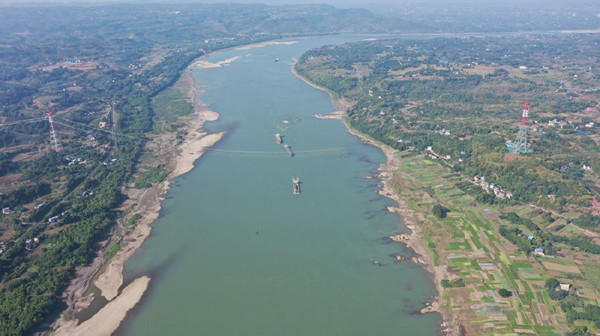Construction of the first Baihetan-Jiangsu ± 800-kilovolt ultra-high voltage (UHV) direct current (DC) power transmission line to cross the Yangtze River was completed on Dec 5.
The line is a part of the Jiangjin Yangtze River crossing project in Southwest China's Chongqing municipality. It was designed by China Energy Engineering Group Shanxi Electric Power Engineering Co., Ltd.
The crossing project has a strain section of 2,504 meters and the width of the river section that the power line spans is about 682 meters.
The long span between the towers and the heavy wires made construction extremely difficult.

A bird's-eye view of the Jiangjin Yangtze River crossing project of the Baihetan-Jiangsu ±800kV UHV DC transmission line [Photo/sasac.gov.cn]
Starting from the Baihetan converter station in Southwest China's Sichuan Province and terminating at Yucheng converter station in East China's Jiangsu Province, the Baihetan-Jiangsu ±800kV UHV DC transmission line stretches from Chongqing across Hubei and Anhui provinces.
The entire line is 2,087 kilometers long and is scheduled to be put into operation in 2022.
It is a key project of China's west-east power transmission program and a demonstration project of the country's new type of power system construction.
Once operational, the project will be able to deliver more than 30 billion kilowatt-hours of hydropower to Jiangsu annually, eliminating burning of 14 million metric tons of coal in East China and reducing an equivalent of 25.42 million tons of carbon dioxide.
The clean power will facilitate the transformation of energy resource advantages into economic advantages in the western regions and improve environment quality in eastern China; it will also optimize China's energy and resource structure and play a role in achieving China's goal of peaking carbon dioxide by 2030 and reaching carbon neutrality by 2060.
(Executive editor: Niu Yilin)